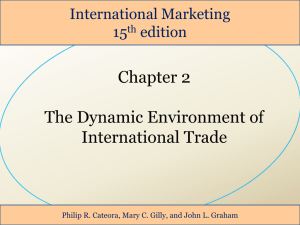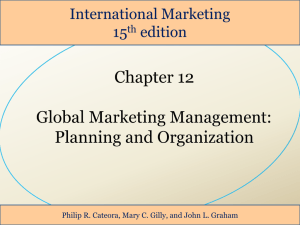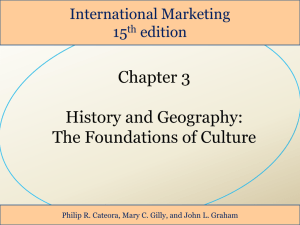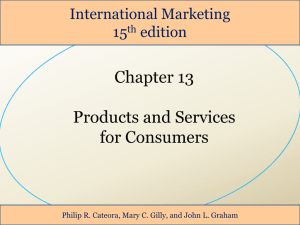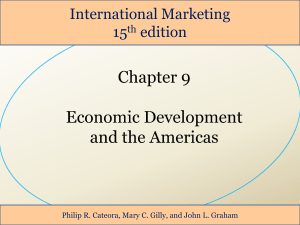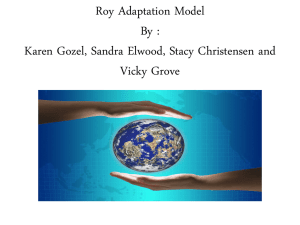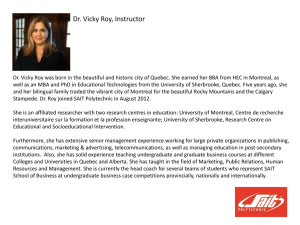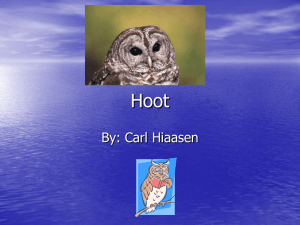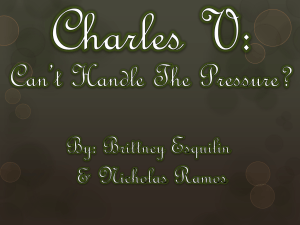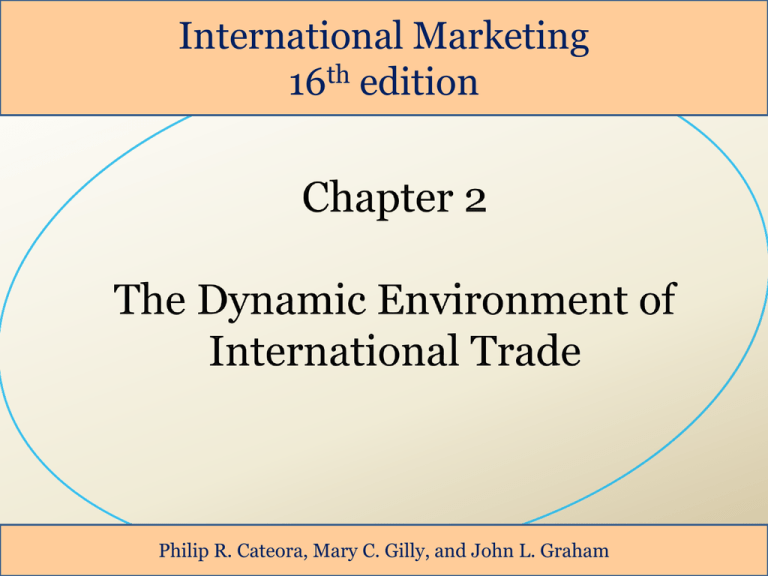
International Marketing
16th edition
Philip R. Cateora, Mary C. Gilly, and John L. Graham
Introduction
2
• History of world trade:
– Stock market crash of 1929; U.S. gave up on free
trade
– Other countries retaliated and world trade
collapsed into a global depression
– After World War II, the U.S. and the
industrialized nations wanted free trade
– World trade increased 22-fold since 1950
– General Agreement on Tariffs and Trade (GATT)
was formed in 1944 to help reduce tariffs
Roy Philip
2
Overview
•
•
•
•
•
•
2
Transition of the world trade from the 20th to
the 21st century
Balance of payments
Protectionism – Logic and illogic
Trade barriers
Easing trade restrictions – GATT, WTO, IMF,
and the World Bank Group
Anti-globalization protests
Roy Philip
3
Global Perspective
Trade Barriers: An International
Marketer’s Minefield
2
• Many countries take advantage of U.S. open markets
while putting barriers in the way of U.S. exports
– Japan (snow skis, rice, baseballs, and beef)
– France (American movies and songs)
– Britain (taxing of P&G’s Pringle potato chips)
• Trade barriers not only limit how much U.S. companies
can sell, they also raise prices for imported products
much higher than they sell for in the U. S.
• Since the birth of the WTO (World Trade Organization),
efforts have been made by many countries to reduce
trade barriers, benefiting the world socially, politically,
and economic ally
Roy Philip
4
The International
Trade Environment
2
Yesterday’s competitive market battles were
fought in western Europe, Japan, and the United
states; now these battles have expanded to Latin
America, eastern Europe, Russia, China, India,
Asia, and Africa.
• This emerging global economy brings significant
advantages to both marketers and consumers:
– Marketers benefit from new markets that give
them viable business opportunities
– Consumers benefit from a wide array of goods at
the lowest prices.
•
Roy Philip
5
Top Ten 2011 U.S. Trading Partners
($ billions, merchandise trade)
2
Exhibit 2.1
Roy Philip
6
2-7
Twentieth to the
2
Twenty-First Century (1 of 2)
• First Half of the Twentieth Century
– The Depression era (1930s) between two world wars WW I (1914-1919) and WW II (1939-1945)
• Capitalism was promoted by the U.S. through the
Marshall Plan:
– Economically rebuilding Europe and Japan
– Fostering economic growth in the underdeveloped
world
• In short, the United States helped make the world’s
economies stronger, which enable them to buy more
from us.
Roy Philip
8
Twentieth to the
2
Twenty-First Century (2 of 2)
• GATT (General Agreement on Tariffs and Trade)
was created in 1986 by world leaders to help
negotiate reductions in tariffs and other trade
barriers.
• WTO (World Trade Organization) was created in
1995 to reinforce GATT rules and legislate trade
disputes.
• Last half of the 20th century marred by
competing approaches to economic development
between the Socialist Marxist and Democratic
capitalist.
Roy Philip
9
World Trade and
2
U.S. Multinationals (1 of 2)
• 21st century ushered in the era of new global
marketing opportunities
• 1950s – U.S. companies began to export and
make significant investments in overseas
marketing and production facilities
• 1960s – U.S. multinational corporations (MNCs)
faced major challenges on two fronts
– Resistance to direct investment
– Increasing competition in export markets
Roy Philip
10
World Trade and
2
U.S. Multinationals (2 of 2)
• American MNCs were confronted by a resurgence of
competition from all over the world
– Japan, Germany, NIC (Newly Industrialized Countries – Brazil,
Mexico, India, South Korea, Taiwan, Singapore , Hong Kong),
developing countries such as Venezuela, Chile, Bangladesh
established SOE (State-Owned Enterprises)
• The U.S. role as an economic powerhouse was challenged on
two fronts:
– U.S. position in world trade (see chart on the next slide)
– U.S. trade deficit (as high as $700 billion in 2007)
• Last decade of the 20th century saw profound changes in the
way world trade would be done
– Free trade zones developed such as NAFTA, AFTA, and APEC
Roy Philip
11
World’s 100 Largest Industrial
Corporations (Annual Revenues)
2
Exhibit 2.2
Roy Philip
12
Beyond the First Decade 2
of the 21st Century (1 of 2)
• Growth of the U.S. economy slowed dramatically in
the last few years especially in 2009
• Economies of the developed world expected on
average to grow annually at 3% for the next 25 years
(OECD)
• Economies of the developing world expected on
average to grow annually at 6% for the next 25 years
(OECD)
• As a result, economic power and influence will move
away from industrialized nations to developing
nations (Latin America, Asia, Eastern Europe, and
Africa)
Roy Philip
13
Beyond the First Decade 2
of the 21st Century (2 of 2)
• Companies are looking for ways to become more
efficient, improve productivity, and expand their
global reach while maintaining an ability to
respond quickly and deliver products that the
markets demand.
– Nestle, Samsung, Whirlpool
• Smaller companies also using novel approaches
to target global markets
– Nochar Inc. (fire retardant)
– Buztronics Inc. (promotional lapel buttons)
Roy Philip
14
International Marketing
16th edition
McGraw-Hill/Irwin
Copyright © 2011 by The McGraw-Hill Companies, Inc. All rights reserved.
Balance of Payments
(1 of 2)
2
• Balance of payments is defined as the system of
accounts that records a nation’s international
finance transactions.
– Transactions recorded annually
– Must always be in balance
– A record of condition, not determinant of condition
Roy Philip
16
Balance of Payments
(2 of 2)
Receipts (+)
2
Payments (-)
• Export sales
• Money spent by foreign
tourists
• Transportation
• Insurance to the U.S.
government
• Dividend and interest on
investments abroad
• Foreign government
payments to the U.S.
• Cost of goods imported
• Spending by American
tourists overseas
• New overseas
investments
• Cost of foreign military
• Economic aid
Roy Philip
17
U.S. Current Account
2
by Major Components, 2009 ($ billions)
Exhibit 2.3
Roy Philip
18
U.S. Current Account
by Major Components, 2011 ($ billions)
2
Exhibit 2.3
Roy Philip
19
U.S. Current Account Balance
(% of GDP)
2
Exhibit 2.4
Roy Philip
20
What Would
One U.S. Dollar Buy?
2
Exhibit 2.5
http://online.wsj.com/mdc/public/page/2_3021-forex.html
Roy Philip
21
International Marketing
16th edition
McGraw-Hill/Irwin
Copyright © 2011 by The McGraw-Hill Companies, Inc. All rights reserved.
Balance of Payments
2
• Balance of payments include three accounts:
– Current account (exports, imports, services, funds)
– Capital account (investments and short-term capital)
– Reserves account (gold, foreign exchange, and
liabilities)
Roy Philip
23
International Marketing
16th edition
McGraw-Hill/Irwin
Copyright © 2011 by The McGraw-Hill Companies, Inc. All rights reserved.
Protectionism
2
• The reality of world trade is that countries
protect its markets from foreign companies by
setting up tariffs, quotas, and nontariff barriers.
• Barriers to trade can take any of the following
forms:
–
–
–
–
Legal (tariffs and quotas)
Exchange
Psychological (nontariffs)
Private market
Roy Philip
25
Protection
Logic and Illogic
2
• Arguments for protectionism:
–
–
–
–
–
–
–
–
–
–
–
Protection of infant industry
Protection of the home market
Need to keep money at home
Encouragement of capital accumulation
Maintenance of the standard of living and real wages
Conservation of natural resources
Industrialization of a low-wage nation
Maintenance of employment and reduction of unemployment
National defense
Increase of business size
Retaliation and bargaining
Roy Philip
26
Does Protectionism Help?
2
• A recent study on 21 protected industries showed that
while jobs are protected, consumers pay much higher
prices because of protectionism:
– U.S. consumers pay about $70 billion per year in
higher prices because of tariffs and other protective
restrictions.
– At the same time, the average cost to consumers for
saving one job in these protected industries was
$170,000 per year.
• Protectionism is politically popular, particularly during
times of declining wages, and/or high employment, but it
rarely leads to renewed growth in a declining industry.
Roy Philip
27
International Marketing
16th edition
McGraw-Hill/Irwin
Copyright © 2011 by The McGraw-Hill Companies, Inc. All rights reserved.
Trade Barriers
•
•
•
•
•
2
Tariffs
Quotas and Import Licenses
Voluntary Export Restraints (VER)
Boycotts and embargoes
Monetary barriers
– Blocked currency
– Government approval
– Differential Exchange rates
• Standards
• Antidumping penalties
• Domestic subsidies and economic stimuli
Roy Philip
29
Trade Barriers
2
• Tariffs are taxes imposed by a government on goods
entering its borders.
Increase
Inflationary pressures, special interests’ privileges,
government control and political considerations in
economic matters, and the number of tariffs
Weaken
Balance-of-payment positions, supply and demand
patterns, and international relations by starting trade
wars
Restrict
Manufacturer’s supply sources, choices available to
consumers, and competition
Roy Philip
30
Trade Barriers
2
• Quotas and Import Licenses
– Quota is a specific unit or dollar limit applied to a
particular type of good (increases price of good)
– Import licenses limits quantities on a case-by-case basis
– Japan and foreign rice; Banana wars between the United
States and the EU
• Voluntary Export Restraints (VER)
– Often used in the 1980s is an agreement between the
importing country and the exporting country for a
restriction on the volume of exports.
– Japan’s VER on U.S. automobiles
Roy Philip
31
International Marketing
16th edition
McGraw-Hill/Irwin
Copyright © 2011 by The McGraw-Hill Companies, Inc. All rights reserved.
The Omnibus Trade and
2
Competitiveness Act (OTCA) 1988
• Many countries are allowed to trade freely
with the United States but do not grant
equal access to U.S. products in their
countries.
• To ease trade restrictions, the OTCA
focused on correcting perceived injustice
in trade practices.
• It dealt with trade deficits, protectionism,
and the overall fairness of our trading
partners.
The General Agreement on
Tariffs and Trade (GATT)
2
• Shortly after World War II, the U.S. and 22 other countries
signed GATT (1947) which paved the way for the first effective
worldwide tariff agreement
• Basic elements of the GATT
– Trade shall be conducted on a nondiscriminatory basis
– Protection shall be afforded domestic industries through
customs tariffs, not through such commercial measures as
import quotas
– Consultation shall be the primary method used to solve global
trade problems
• Eliminating international trade barriers – Uruguay Round
– The General Agreement on Trade in Services (GATS)
– Trade-Related Investment Measures (TRIMs)
– Trade-Related aspects of Intellectual Property Rights (TRIPs)
Roy Philip
34
The World
Trade Organization (WTO)
2
• WTO which is an institution, not an agreement, was founded
in 1994.
– Sets many rules governing trade between its 148 members
– Provides a panel exports to hear and rule on trade disputes
between members
– Issues binding decisions
– All member countries will have equal representation
– Member countries have open their markets and to be bound by
the rules of the multilateral trading system
• U.S. ratification concerns
– Possible loss of sovereignty over its trade laws to WTO
– Lack of veto power
– Role U.S. would assume when a conflict arises over an individual
state’s laws that might be challenged by a WTO member
• China became member of the WTO (2001); Vietnam (2007)
Roy Philip
35
Skirting the spirit of
GATT and WTO
2
• Loopholes
– China reduced tariffs while at the same time
increased number and scope of technical
standards and inspection requirements
• Imposing antidumping duties
• Negotiating bilateral trade agreements
– May lead to multinational concessions
– Not necessarily consistent with WTO goals
and aspirations
Roy Philip
36
International Monetary Fund
(IMF)
2
• Because of inadequate money reserves
and unstable currencies, the IMF was
created to assist nations in becoming and
remaining economically viable
• Objectives of the IMF
– Stabilization of foreign exchange rates
– Establishment of freely convertible currencies
to facilitate the expansion and balanced
growth of international trade
Roy Philip
37
World Bank Group
2
• By promoting sustainable growth and investment in people,
the World Bank Group is an institution created in 1944 to
reduce poverty and improve standard of living
• The World Bank has five institutions which perform the
following services:
– Lending money to the governments of developing countries
– Providing assistance to governments for developmental projects
to the poorest developing countries (per capital incomes of $925
or less)
– Lending directly to the private sector
– Providing investors with guarantees against “noncommercial
risk”
– Promoting increased flows of international investment
Roy Philip
38
Anti-globalization Protests
2
• The unintended consequences of globalizing
–
–
–
–
–
Environmental concerns
Worker exploitation and domestic job losses
Cultural extinction
Higher oil prices
Diminished sovereignty of nations
• Protests
–
–
–
–
–
WTO meeting in Seattle (November 2009)
World Bank and IMF meetings in Washington D.C. (April 2010)
World Economic Forun meeting in Australia (September 2010)
IMF meeting in Prague (September 2010)
Terrorism in London (2005)
• “Antisweatshop” campaigns
Roy Philip
39
Summary (1 of 2)
2
• Heightened worldwide competition has
increased pressure for protectionism from every
region of the globe when open markets are
needed
• Although there are arguments in favor of
protectionism, the consumer seldom benefits
from such protection
• Free trade in international markets help
underdeveloped countries become self-sufficient
Roy Philip
40
Summary (2 of 2)
2
• Free trade will always be partially threatened by
various governmental and market barriers that
exist or are created for the protection of local
businesses
• The future of open global markets lies with the
controlled and equitable reduction of trade
barriers
Roy Philip
41

